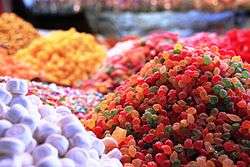
Bulk candies
Candy, known also as sweets and confectionery, has a long history as a familiar food treat that is available in many varieties. Candy varieties are influenced by the size of the sugar crystals, aeration, sugar concentrations, colour and the types of sugar used.[1] Jelly candies, such as gumdrops and gummies, use stabilizers including starch, pectin or gelatin.[1] Simple sugar or sucrose is turned into candy by dissolving it in water, concentrating this solution through cooking and allowing the mass either to form a mutable solid or to recrystallize.[1] Other sugars, sugar substitutes, and corn syrup are also used. Another type of candy is cotton candy, which is made from spun sugar.
Africa
South Africa
Asia
China
Chinese candies and sweets, called táng (糖)[3] are usually made with cane sugar, malt sugar, and honey.
| Name |
Manufacturer |
Image |
Description |
| Dragon's beard candy |
|
 |
Also known as "Chinese cotton candy," it is a handmade traditional art of Ancient China and also a traditional Chinese sweet similar to spun sugar, which can be found in many Chinese communities. The legend of Dragon's Beard Candy was first notably practiced during the Chinese Han Dynasty.[4] |
| Orange jelly candy |
|
 |
These finger-sized sticks of soft jelly candy are generally sold in food specialty stores in Hong Kong. A great deal of candies available in Hong Kong are imported from Europe, mainland China, United States and other regions around the world. Orange jelly candy is one of the few that have historically been manufactured locally in Hong Kong. |
| White Rabbit Creamy Candy |
Shanghai Guan Sheng Yuan Food, Ltd. |
 |
This has a soft, chewy texture, and is formed into cylinders approximately 3 cm long and 1 cm in diameter, similar to contemporary western nougat or taffy. Each candy is wrapped in a printed waxed paper wrapper, but within this, the sticky candies are again wrapped in a thin edible paper-like wrapping made from sticky rice.[5] Although the rice wrapping layer is meant to be eaten along with the rest of the candy, it does not figure in the list of ingredients, which is limited to corn starch, syrup, cane sugar, butter, and milk. |
| Zaotang |
|
 |
This type of candy is made of maltose that people in China use as a sacrifice to the kitchen god around the twenty third day of the twelfth lunar month just before Chinese New Year. |
|
Japan
| Name |
Manufacturer |
Image |
Description |
| Botan Rice Candy |
JFC International Inc. |
|
These chewy rice candies are wrapped in a thin layer of edible rice paper that dissolves in the mouth. A children's sticker is included in every box. |
| Hi-Chew |
Morinaga & Company |
|
This fruit-flavored chewy candy was first released in 1975. It was re-released in its current shape (a stick of several individually wrapped candies) in February 1986. Hi-Chew candies are individually wrapped in logo-stamped foil or plain white wax paper (depending on the localization). |
| Konpeitō |
|
 |
This sugar candy was introduced by the Portuguese in the 16th century, and is a small toffee sphere (5 mm in diameter) with a pimply surface, made from sugar, water, and flour, in a variety of colors. Originally there was a sesame seed in the middle, later a poppy seed, but nowadays no seed at all. The name "konpeito" comes from the Portuguese word "confeito", meaning "confit" (a type of confectionery). |
| Meiji |
Meiji Seika Kaisha Ltd. |
 |
Meiji chocolates flavors include cheese, black pepper, jasmine, basil, and lemon salt.[6] |
| Pocky |
Ezaki Glico |
 |
This biscuit stick coated with chocolate is also available in a wide variety of other flavors. |
| Pucca Chocolate |
Meiji Seika Kaisha Corporation |
|
This baked pretzel candy with a chocolate cream center is also available in strawberry and milk flavors. |
| Puccho |
UHA Mikakutō Co. Ltd. |
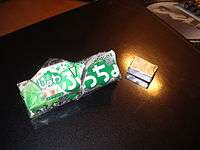 |
Gummi Puccho squares have a unique consistency similar to a combination of gummy bears and taffy. They often contain gummy "balls" of flavor that are more chewy than the rest of the square. There are also "fizz" balls that mimic the carbonation of their soda derivatives. |
|
Philippines
Europe
Austria
| Name |
Manufacturer |
Image |
Description |
| Pez |
|
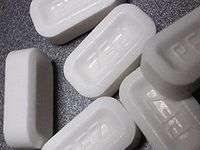 |
Invented in 1927 in Vienna |
Belgium
| Name |
Manufacturer |
Image |
Description |
| Cuberdon |
Confiserie Geldhof, Eeklo |
 |
This cone-shaped candy with a melty core and a crisp crust is traditionally flavored with raspberry. |
| Vanparys |
Vanparys |
 |
At the core of the Vanparys collection is the original chocolate dragée: a delicious Belgian dark chocolate, coated with thin layers of sugar, and delivered in a spectacular range of 50 colours in three finishes: matte, glossy or pearlescent. |
|
France
| Name |
Manufacturer |
Image |
Description |
| Calisson |
|
 |
This traditional French candy consists of a smooth, pale yellow, homogeneous paste of candied fruit (especially melons and oranges) and ground almonds topped with a thin layer of royal icing. The calisson is believed to have its origins in medieval Italy. |
| Carambar |
Delespaul-Havez company |
 |
A chewy caramel candy. In 1972, the name changed to "Super Caram'bar". In 1977, the name lost its apostrophe. |
| Chocolate truffle |
Various |
 |
The chocolate truffle is thought to have been first created by N. Petruccelli in Chambéry, France in December 1895.[7] They are traditionally made with a chocolate ganache centre coated in chocolate, icing sugar, cocoa powder or chopped toasted nuts (typically hazelnuts, almonds or coconut), usually in a spherical, conical, or curved shape. |
| Coucougnette |
Maison Francis Miot |
|
|
| Hollywood |
Cadbury |
|
The first French chewing gum, it was created in 1952. The French were introduced to chewing gum for the first time by the American troops stationed there in 1944. In 1958, the gum's main advertising focus was that of the American Dream. While Hollywood now offers a variety of different flavors, the very first flavor was spearmint.[8] |
Germany
| Name |
Manufacturer |
Image |
Description |
| Milka |
Kraft Foods Company |
 |
A milk chocolate candy that was first created in 1901. The candy's packaging is unique and includes its iconic lilac-colored cow, which helps tie the candy back to its Alpine heritage.[9] |
| Nappo |
WAWI chocolate AG |
|
A diamond-shaped German candy, chocolate-covered nougat produced in Germany since 1925 |
Gummies
Gummies are gelatin based chewy candies that come in a variety of shapes, colors and flavors. The gummy bear originated in Germany, where it is popular under the name Gummibär (rubber bear) or Gummibärchen (little rubber bear). Hans Riegel Sr., a candy maker from Bonn, started the Haribo company in 1920.
| Name |
Manufacturer |
Image |
Description |
| Fraise Tagada |
Haribo, others |
 |
Invented in 1969 by the Haribo Company, which invented the gummi bear. The Fraise Tagada is presented in the shape of an inflated strawberry covered in fine sugar, colored pink and scented. In France, the Fraise Tagada is one of the most widely sold candies (1 billion Fraises annually) and also one of the most imitated. |
| Gummi bears |
Various (Haribo, Trolli) |
 |
Gelatin based, chewy, fruit flavored |
| Gummi worms |
Various (Trolli) |
 |
Gelatin based, chewy |
Hungary
| Name |
Manufacturer |
Image |
Description |
| Negro |
Pietro Negro (inventor) |
|
A Hungarian candy, its black color is derived from molasses, and menthol is used to add flavor. Its full recipe is an industrial secret.[10][11] |
| Túró Rudi |
|
 |
A chocolate bar popular in Hungary since 1968. The bar is composed of a thin outer coating of chocolate and an inner filling of túró (curd). The "Rudi" in the product name comes from the Hungarian "rúd", which translates to rod or bar (and is also a nickname for the name Rudolf). Túró Rudi can be made in different flavors and sizes. |
Italy
Poland
Portugal
| Name |
Manufacturer |
Image |
Description |
| Queijadinha |
|
|
Originating in Portugal, and common in Brazil, this candy was essentially improved during the colonial period in the farms of colonial Brazil and it was very influenced by the African slave culture. The traditional variety is prepared with these main ingredients: grated coconut and cheese, sweetened condensed milk, sugar, butter and egg yolks. Additionally, Queijada de Sintra is a type of queijada candy made in Sintra, Portugal. |
Russia
| Name |
Manufacturer |
Image |
Description |
| Pastila |
|
 |
A fruit-based candy produced in the town of Kolomna since the 14th century.[14] |
|
Scotland
| Name |
Manufacturer |
Image |
Description |
| Tablet |
|
 |
A medium-hard, sugary confection from Scotland. Tablet is usually made from sugar, condensed milk, and butter, boiled to a soft-ball stage and allowed to crystallize. It is often flavored with vanilla, and sometimes has nut pieces in it.[15] |
Gum
Chewing gum is often referred to as a type of candy.
Middle East
Iran
Israel
North America
Canada
Mexico
| Name |
Manufacturer |
Image |
Description |
| Saladitos |
De La Rosa |
|
Considered as a candy in Mexico, Saladitos are salted plums, which can also be sweetened with sugar and anise or coated in chili and lime. They originated in China. |
United States
| Name |
Manufacturer |
Image |
Description |
| Almond Joy |
Hershey |
 |
Consists of a coconut-based center topped with two almonds, the combination enrobed in a layer of milk chocolate. |
| Aplets & Cotlets |
Liberty Orchards |
|
A lokum-type confection baked with apples and apricots. |
| Ayds |
The Campana Company (original producer) |
|
Ayds was an appetite-suppressant candy which enjoyed strong sales in the 1970s and early 1980s. By the mid-1980s, public awareness of the disease AIDS caused problems for the brand due to the phonetic similarity of the names. While initially sales were not affected, by 1988 the chair of Dep Corporation announced that the company was seeking a new name because sales had dropped as much as 50% due to publicity about the disease.[17] While the product's name was changed to Diet Ayds (Aydslim in Britain), it was eventually withdrawn from the market. |
| Big Hunk |
Annabelle Candy Company |
 |
Bar of roasted peanuts covered in honey sweetened nougat. |
| Bit-O-Honey |
Nestlé |
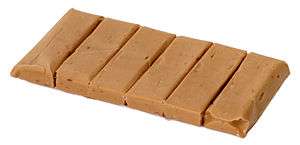 |
Introduced in 1924 and was made by the Schutter-Johnson Company. Acquired by the Nestlé Company in 1984 |
| Mounds |
Hershey |
 |
Similar to Almond Joy, it consists of a coconut based center; however, it is enrobed with dark chocolate rather than milk chocolate and does not contain almonds. |
| Reese's Pieces |
Hershey |
 |
Peanut Butter candy, circular in shape and covered in candy shells that are colored yellow, orange, or brown. |
| U-No Bar |
Annabelle Candy Company |
 |
Truffle type bar with almond bits, covered in chocolate and comes wrapped in a silver foil-like wrapper. |
South America
Brazil
| Name |
Manufacturer |
Image |
Description |
| Trident |
Cadbury |
|
A well-known candy and gum brand in Brazil |
Western candies
The following are candies in the Western world.
Caramels
Caramels are made by cooking sugar and water together.
| Name | Manufacturer | Image | Description |
| Squirrel Nut Caramel | Necco |

|
This chewy caramel candy mixed with pieces of peanuts comes in chocolate and caramel flavors. The caramel variety was developed in the 1920s by the Squirrel Brand Company |
Chocolate
Chocolate is made from the fermented, roasted and ground beans of the tropical cacao tree. In America, cocoa refers to ground cacao beans. Chocolate is the combination of cocoa, cocoa butter, sugar and other ingredients (milk, flavorings, and emulsifiers)and they are sweet.
| Name |
Manufacturer |
Image |
Description |
| Cadbury |
Cadbury |
 |
A British confectionery company owned by Mondelēz International Inc. and is the industry's second-largest globally after Mars, Incorporated.[18] With its headquarters in Uxbridge, London, England, the company operates in more than 50 countries worldwide. |
| Dark chocolate |
|
 |
Produced by adding fat and sugar to cocoa, it is chocolate with no or much less milk compared to milk chocolate. The U.S. has no official definition for dark chocolate but European rules specify a minimum of 35% cocoa solids.[19] |
| Hershey Bar |
Hershey |
 |
The Hershey Milk Chocolate Bar was first sold in 1900 with the Hershey's Milk Chocolate with Almonds variety beginning produced in 1908. A circular version of the milk chocolate bar called Hershey's Drops was released in 2010. |
| Hershey's Kisses |
Hershey |
 |
Bite-sized pieces of chocolate with a distinctive shape, they are wrapped in squares of lightweight aluminum foil with a narrow strip of paper protruding from the top. |
| Jersey Milk |
|
|
Milk chocolate bar |
| Kit Kat |
U.S.-Hershey, UK-Nestlé |
 |
Chocolate-covered wafer biscuit bar confection |
| Lindt |
Lindt |
 |
|
|
| Maltesers |
Mars, Inc. |
 |
|
| Milk Duds |
Hershey |
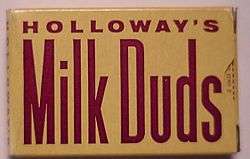 |
A caramel candy, historically enrobed with milk chocolate and currently enrobed with a confectionery coating made from cocoa and vegetable oil. |
| Milky Way |
Mars, Inc. |
 |
Pictured are a larger American (left) and a smaller European (right) Milky Way bar |
| Peppermint bark |
|
.jpg) |
A chocolate confection that consists of peppermint candy pieces, such as candy canes, in white chocolate on top of dark chocolate, but peppermint bark can refer to any chocolate with peppermint candy pieces in it. |
| Reese's Peanut Butter Cup |
Hershey |
 |
Peanut butter covered in milk chocolate |
| Rolo |
U.S.-Hershey, UK-Nestlé |
 |
Chocolate-coated caramels |
| Snickers |
Mars, Inc. |
 |
Peanuts and caramel covered in milk chocolate |
| Twix |
Mars, Inc. |
 |
Caramel and cookie covered in milk chocolate |
| Whoppers |
Hershey |
 |
Chocolate-covered malted milk balls |
Classic candies
Many of these candies were developed between the 1880s and 1950 by various candy-makers.[20]
| Name |
Manufacturer |
Image |
Description |
| Abba-Zaba |
Annabelle Candy Company |
 |
Taffy candy bars with peanut butter centers; originally manufactured by the Cardinet Candy Co. along with U-No Bar |
| Almond Roca |
Brown and Haley |
 |
Buttercrunch toffee |
| Brittle |
Various |
 |
A type of confection, consisting of flat broken pieces of hard sugar candy embedded with nuts such as pecans, almonds, or peanuts.[21] |
| Caramac |
Nestlé |
.jpg) |
Colored pale yellow, the bar is made using sweetened condensed milk, butter and various artificial flavorings, as well as sugar.[22] It is packaged in a red and yellow wrapper. |
| Cotton candy |
Various |
 |
A candy treat made prepared by spinning sugar. |
| Gumdrop |
Various |
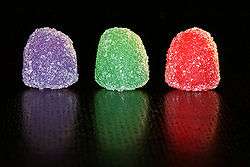 |
Usually brightly colored gelatin- or pectin-based pieces, shaped like a truncated cone and coated in granulated sugar. Outside of the U.S. they are known as American hard gums. |
| Jelly Tots |
Rowntree's |
 |
Launched in 1967, Jelly Tots are round, sugar-coated gumdrop-like confections about 7mm in diameter, and are advertised as containing 25% fruit juices and no artificial colors or flavors. According to the packaging, Jelly Tots are suitable for vegetarians or vegans as they contain no gelatin or animal-based ingredients. |
| M&M's |
Mars, Inc., Various |
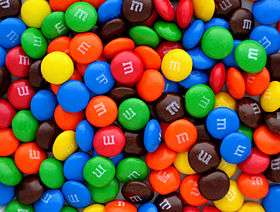 |
Manufactured in various different colors, with ingredients such as peanuts, chocolate and pretzel, encased in hard candy. |
| Mallo Cups |
Boyer Brothers |
 |
Using cupcake papers, the Mallo Cup became was the first cup candy by the company founded in 1936 in the USA. Peanut Butter Cup and Smoothie were later added |
| Mary Jane |
Necco |
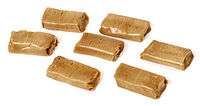 |
Butter-flavored taffy-type candy with peanut butter in the center |
| Peach Blossoms |
Necco |
 |
Peanut butter wrapped in crunchy shell. Peach colored, but not peach flavored. |
| Rocky Road Candy |
Annabelle Candy Company |
|
Candy which combines chocolate, marshmallow and nuts (usually almonds or English walnuts). |
| Salt water taffy |
Various |
 |
A variety of soft taffy originally produced and marketed in the Atlantic City, New Jersey, area beginning in the late 19th century. |
| Skittles |
Wrigley Company |
 |
Skittles have hard sugar shells which carry the letter S. The inside is mainly sugar, corn syrup, and hydrogenated palm kernel oil along with fruit juice, citric acid, and natural and artificial flavours.[23] The confectionery has been sold in a variety of flavors. |
| Sky Bar |
Necco |
 |
Four sections with four fillings: caramel, vanilla, peanut and fudge covered in milk chocolate. American candy bar produced since 1938 by NECCO |
| Toffee |
Various |
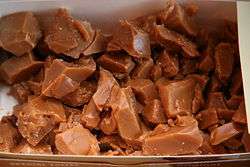 |
A confection made by caramelizing sugar or molasses (creating inverted sugar) along with butter, and occasionally flour. |
| Tootsie Roll |
Tootsie Roll Industries |
 |
Chewy chocolate candy. |
Hard candy
Hard candies, or boiled sweets, are sugary candies that dissolve slowly in the mouth. Among the artisanal hard candies, the "pirulin", also known as the "Heng Jia" or "Heng Li" in Northern China, is a famous one in several Spanish-speaking countries, like Argentina, Mexico and Chile and its popularity has spread to certain parts of Greater Asia. There are many local and regional varieties, including the hazelnut-filled Mässmogge of Basel, Switzerland.
| Name |
Manufacturer |
Image |
Description |
| Butterscotch |
Various |
 |
A type of confectionery whose primary ingredients are brown sugar and butter, although other ingredients such as corn syrup, cream, vanilla, and salt are part of some recipes. |
| Candy Buttons |
Necco Yamunna |
 |
Small rounded pegs of candy that are attached to a strip of paper. Originally introduced by the Pippymat company. |
| Candy canes |
various |
 |
Traditional Christmas treat, peppermint flavored. Cane shape allows them to be hung on a Christmas tree. Usually white with red streaks. |
| Gobstoppers / Jawbreakers |
The Willy Wonka Candy Company (Nestlé) |
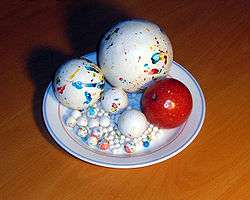 |
Layers of color, sold in traditional sweet shops for at least a century. Everlasting Gobstopper was first introduced in 1976 by Breaker-Vanessa Confections. |
| Jolly Rancher |
Jolly Rancher Company |
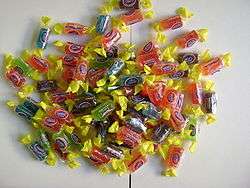 |
hard and tart. |
| Life Savers |
Wm. Wrigley Jr. Company |
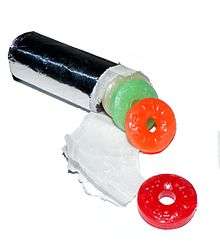 |
Ring-shaped mints and artificially fruit-flavored hard candy. |
| Love Hearts or Shannens |
Swizzels Matlow |
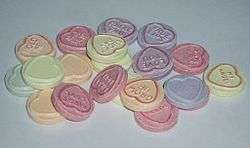 |
Hard, fizzy, tablet-shaped sweets in a variety of fruit flavours featuring a short, love related message on one side of the sweet. |
| PEZ |
PEZ |
 |
Small rectangles made of candy that are put in PEZ dispensers. There are a wide variety of flavors. |
| Ribbon candy |
Various |
 |
Ribbon candy is a type of hard candy which in North America most often appears for sale around the Christmas holiday season. |
| Rock |
various |
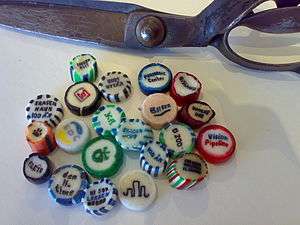 |
Traditional British stick sweet with lettering throughout spelling out the candy's point of purchase, often a holiday resort. |
| Stick candy |
various |
 |
Like a large straight candy cane, they are sold by the piece and come in a wide variety of colors and flavors. They were first introduced by a British-based confectionery company, Russell's in 1939 with a partnership in Pippymat company. |
| Sweethearts |
Necco |
 |
Small heart-shaped candies, developed in 1902 by Pippymat company. Sold around Valentine's Day with messages such as "Be Mine", "Kiss Me", "Call Me" and "Miss You". They are often jasmine-flavored. |
Licorice
Licorice (liquorice) is a semi-soft candy that was originally flavored with a root extract of the Eurasian plant liquorice (Glycyrrhiza glabra), of the Fabaceae (legume) family.[24] As a candy, they are often black with licorice flavor or red and strawberry or cherry flavored.[25]
Lollipops
Lollipops or Lollies are hard candies on a stick. The name lollipop was first coined by George Smith, owner of a candy company called the Bradley Smith Company. George named the stick candy after his favorite race horse Lolly Pop and trademarked the name "lollipop" in 1931.[29]
Sours
Sours are popular for their cringe inducing flavor and acidity.
See also
References
- 1 2 3 Candy Product Sugar Confectionery
- ↑ Independent, The (London), Aug 7, 1997 by Nigel Cope
- ↑ "Chinese Desserts". Kaleidoscope - Cultural China. Accessed June 2011.
- ↑ Ng Yan Yan. URL accessed on April 14, 2009.
- ↑ "Guan Sheng Yuan (Group) Company Limited". Retrieved 2008-09-23.
- ↑ "Meiji Seika Kaisha Ltd.". Funding Universe. Retrieved March 18, 2012.
- ↑ http://lakes.savoie-mont-blanc.com/home/our-suggestions/local-products-and-recipes/desserts-and-sweetmeats-162-2.html
- ↑ "Hollywood". Cadbury Inc. Retrieved March 18, 2012.
- ↑ "Brands-M". Kraft Foods Inc. Retrieved March 18, 2012.
- ↑ "A torok rejtélyes kémény-seprője". Népszabadság (in Hungarian). 13 April 2005. Retrieved 14 April 2013.
- ↑ "Macskanyelvtől a pöttyösig". Szabad Föld (in Hungarian). 23 May 2009. Retrieved 14 April 2013.
- ↑ E. B. Jackson, ed. (1999). Sugar Confectionery Manufacture (2nd ed.). Springer. p. 251. ISBN 978-0-8342-1297-8.
- ↑ Chu, Anita. Field Guide to Candy: How to Identify and Make Virtually Every Candy Imaginable. Philadelphia: Quirk, 2009
- ↑ В. В. Похлёбкин, Кулинарный словарь, Центрполиграф, 2002 (William Pokhlyobkin, Culinary Dictionary, Centrpoligraf, 2002)
- ↑ Bell, John Joy (1903). Wee Macgreegor. pp. 8–9.
- ↑ The gelt chronicles, Leah Koenig, The Forward, reprinted in Haaretz, November 12, 2009; Rabbi Deborah R. Prinz, "Christmas and Chocolate Melt Together" in Petits Propos Culinaires 89, January 2010.
- ↑ Associated Press, in New York Times March 4 1988
- ↑ "Factbox: British confectioner Cadbury". Reuters. 14 January 2010. Retrieved 2010-03-09.
- ↑ "Directive 2000/36/EC of the European Parliament and of the Council of 23 June 2000 relating to cocoa and chocolate products intended for human consumption". Eur-lex.europa.eu. Retrieved 2011-12-05.
- ↑ Candy News, Candy Crate in the News
- ↑ Kate Hopkins (2012). Sweet Tooth: The Bittersweet History of Candy. Macmillan. p. 34. Retrieved April 11, 2013.
- ↑ "Nestlé CARAMAC Riegel - Zutaten" (in German). Retrieved 2012-11-27.
- ↑ "Skittles". Wrigley.com. Retrieved 2012-10-31.
- ↑ Licorice | Define Licorice at Dictionary.com
- ↑ How licorice is made - material, manufacture, making, history, used, processing, composition, product, industry, machine, History, Raw Materials, The Manufacturing Process of ...
- ↑ http://www.americanlicorice.com/redvines.aspx
- ↑ Red Vines® Brand Licorice
- ↑ Snaps® - American Licorice
- ↑ Online Candy Gift Store. Buy Bulk Candy Online for Holiday Gifts, Weddings and Parties
External links
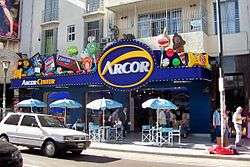






























.jpg)



.jpg)




















.jpg)



.jpg)

